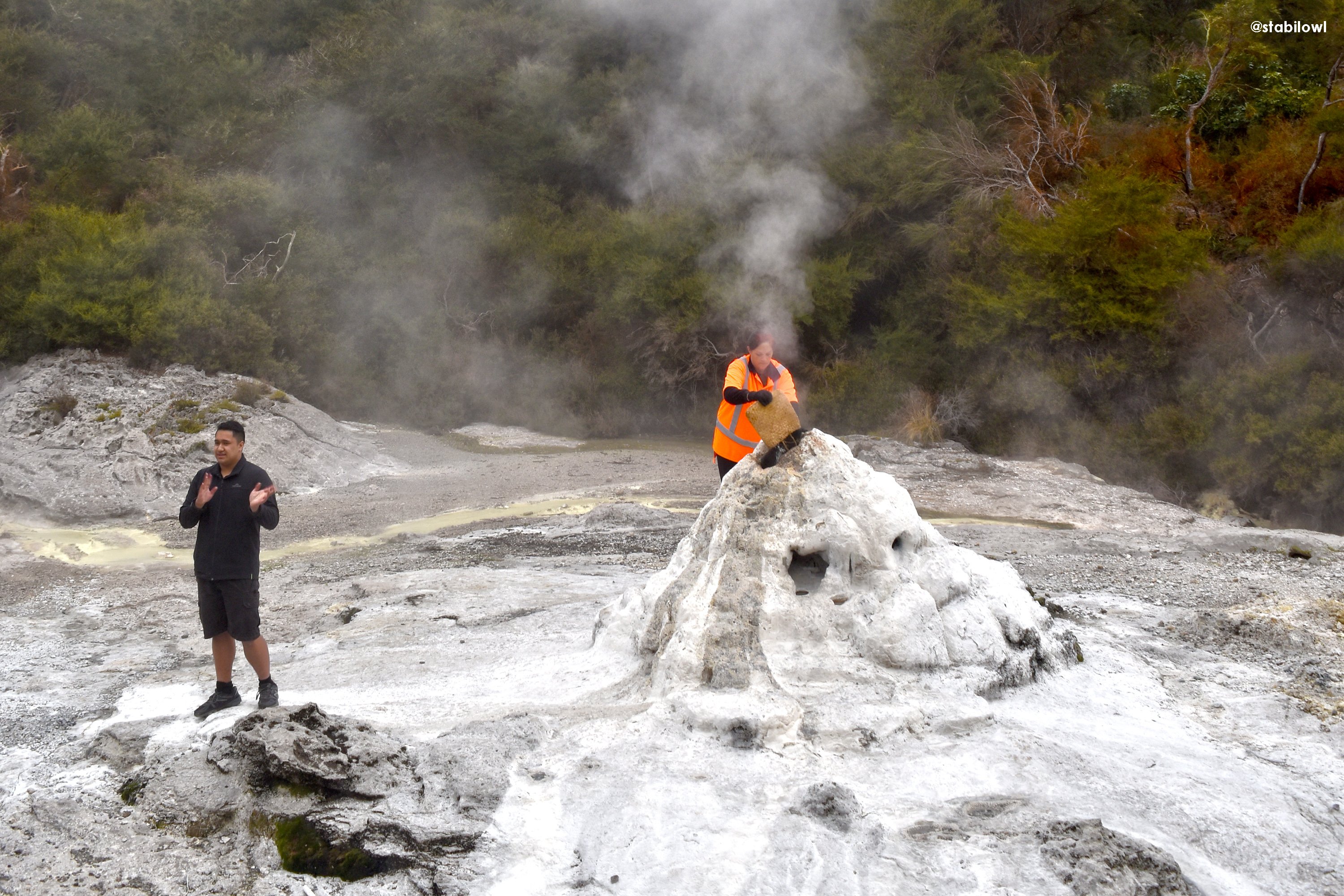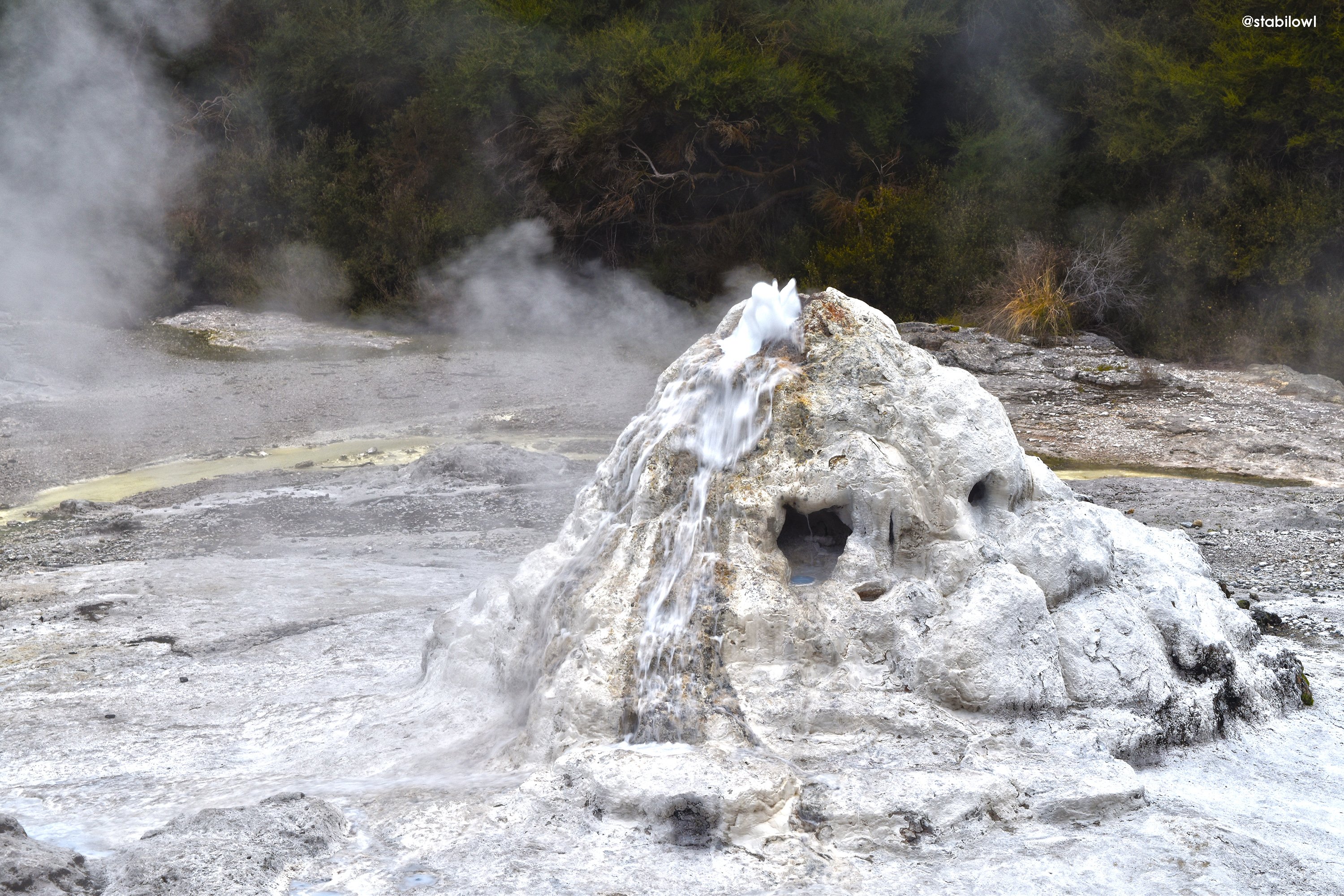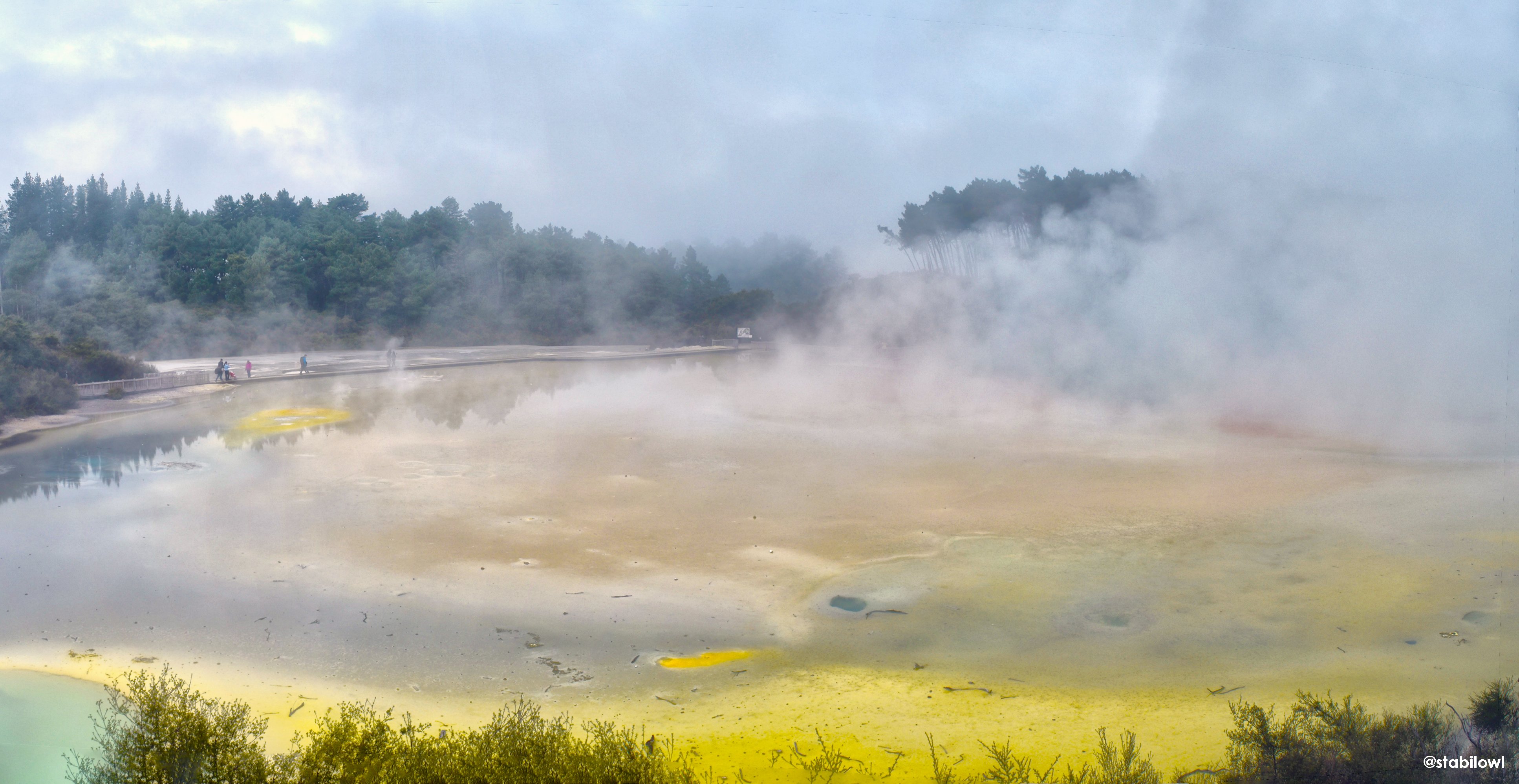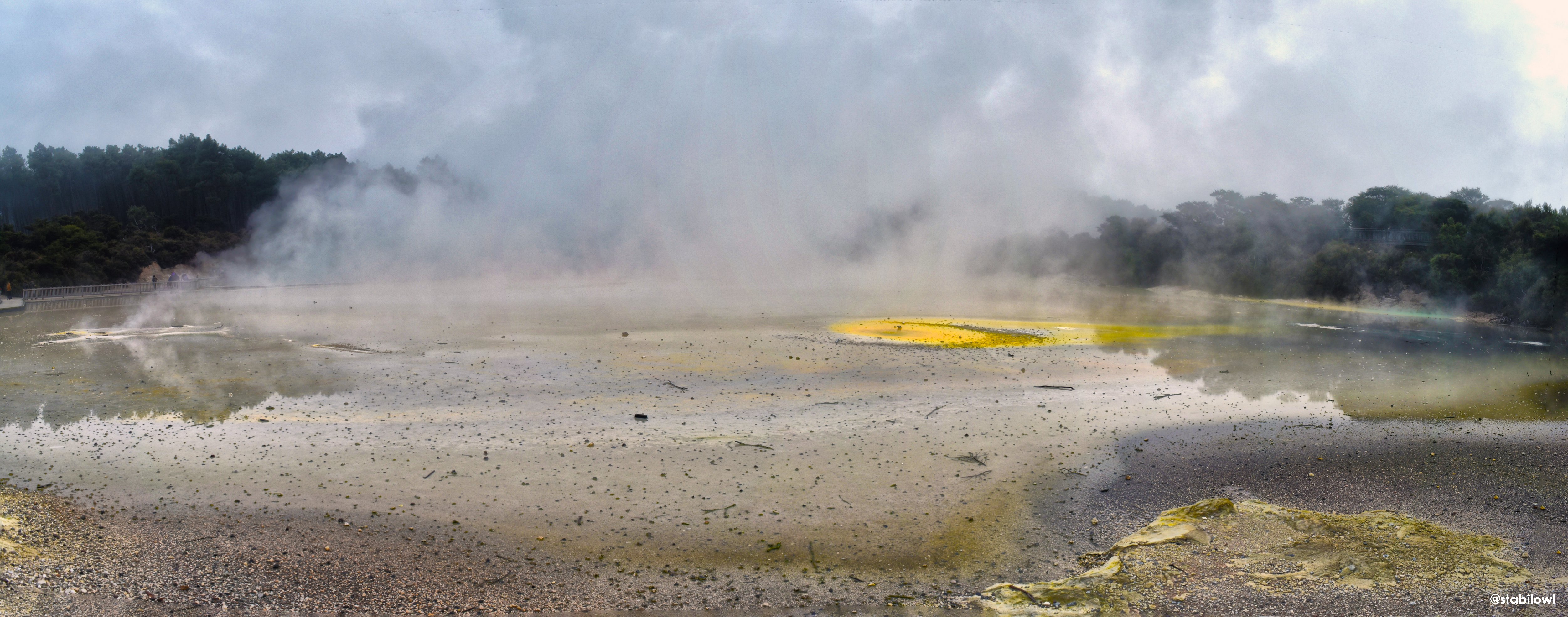
Rotorua is a town in the centre of the North Island, New Zealand, and is famous for its Maori Culture and Geothermal activities. About 3 hours drive from Auckland, Rotorua is a famous attraction even back in the early 20th Century before airplanes were invented, where European visitors would endure the three weeks travelling time just to come here to see the geothermal landscape and enjoy the healing power of the hot springs. One of the more famous geothermal attraction is the Waiotapu Geothermal Wonderland. About 30 minutes drive from downtown Rotorua, Waiotapu is one of the largest active geothermal sites in the area, and is also the most developed. Waiotapu literally means Sacred Waters in the Maori Language, and was one of the many geothermal features in the area that provided the local Maori tribes warmth, food and defense before becoming tourist attractions. With a $32.5 NZD ticket which you could buy online or onsite, you can visit three different sites adjacent to each other in the Waiotapu Geothermal Wonderland: the Lady Knox Geyser, the Waiotapu Geothermal Walk, and the mud pools. We went to the Lady Knox Geyser first, because it only goes off once per day at 10:15 am.
罗托努亚是新西兰北岛中心的一座小镇,以毛利土著文化和地热风貌为名。这个离奥克兰大约三个小时车程的旅游小镇早在二十世纪初就吸引了不少的欧洲游客踏上长达三星期的航海旅程来这欣赏地热带来的自然景观和温泉疗养。其中最有名也开发得最好的地热景观是怀奥塔普地热奇景。怀奥塔普在毛里语里意为神圣之水,是在罗托努亚周边众多地热地区之一,在欧洲殖民者到达前为附近的毛里土著提供了天然热水,食物和天然的防御。怀奥塔普地热公园的门票可以在网上或在怀奥塔普的游客中心购买。只需 $32.5 NZD, 就可以游览怀奥塔普的三大景点:诺克斯夫人喷泉、怀奥塔普地热公园和热泥潭。因为诺克斯夫人喷泉每天只在早上十点十五分喷一次,它理所当然的成了我们怀奥塔普之旅的第一站。

Lady Knox Geyser 诺克斯夫人间歇泉

A Geyser is a natural fountain where water periodically or a periodically spurt out water from the ground. At Waiotapu there is a giant geyser that know as The Lady Knox Geyser that is scheduled to go off every morning at around 10 am. Unlike most geysers where the eruption is caused by the natural built up of water pressure underground, the Lady Knox Geyser erupts by human intervention. Legend has it that back in the days when European settlers first came to the area, they built a prison adjacent to a forest. One day, three convicts were directed to explore the area, and found a hotspring, which was a perfect place for a soak and for washing their clothes. So the next day, they brought with them soap and washing powder, and had a pleasant clean in the warm relaxing hotspring. However, it turns out that the chemical composition of the pool water was such that it reacts with the soap and washing powder, and triggered a reaction so violent that the hotspring erupted into a giant geyser. This geyser is, of course, the Lady Knox Geyser. While the prisoners escaped butt naked but unharmed, the hot pool was drained, and all was left was the vent of the geyser. To reenact the eruption, the guide pour some washing powder into the vent. At first, the vent just kept on steaming like it was previously. But soon, bubbles started to flowed out from the vent. Gently at first, but more and more vigorous as if it is starting to boil. Then came some rumbling sounds underground, and suddenly, the geyser erupted, with hot water spurting up 20 meters high above the ground. Steam and water spray shrouded the area while jets of water reaching high up into the sky. It was truly a magnificent sight to behold.
间歇泉是因地热而形成的喷泉。当地下河流或其他水源流过有地热活动的洞穴,水流遇热变成蒸汽。洞穴的地型让蒸汽不易流失,促使洞穴里的气压上升,最后气压过高而引起爆发,连气带水从洞穴口涌出变成喷泉。因为气压需要时间去累积,所以间歇泉通常会间歇性的爆发,因而得名。然而,诺克斯夫人喷泉有别于其他喷泉 - 它的爆发是人为的!相传二十世纪初,欧洲殖民者在怀奥塔普附近建了一所监狱,然后让囚犯在附近探索和清理附近的树林,把它们变成耕地。有一天,几个囚犯来到诺克斯夫人喷泉的所在地,在茂密的树林里发现了一个大温泉。囚犯们喜出望外,于是第二天他们带上了肥皂和洗衣粉,在温泉了泡澡,搓衣服。然而他们不知道,洗衣粉和肥皂会和这里的温泉水产生特别的化学反应。这些强烈的化学反应最后导致整个温泉大爆发,爆发后泉水干涸,只留下了一个小穴口形成了诺克斯夫人喷泉。为了给游客们演示洗衣粉的威力,工作人员走到喷泉口,倒进去一大包洗衣粉。果然不到一会,一直在静静冒烟的喷泉口开始口吐白沬。白沬越来越多,从轻轻淌出变成激烈的溢出。只听地下开始隆隆作响,然后随着一声巨响,二十米高的水柱伴随着白茫茫的蒸汽从泉口喷出,冲往天际。虽然这喷泉的爆发不是纯天然,可是还是非常壮观。





Waiotapu Geothermal Park 地热公园步行径

The geothermal walk starts about 500m from the Lady Knox Geyser. So after watching the geyser display we proceed to the geothermal park where we started exploring the area. At the visitor centre before entering the park, there are bathrooms, a souvenir store and a cafe. But most importantly, after buying or exchanging your tickets you will be given the map of the Park which plotted out the available walks and well as the description of each sight. We entered the park and walk across the a bridge that crosses a stream that is steaming in the distance. We are not sure whether the water is warm, but many birds, including the native fantail, seems to be enjoying it. The winding but well maintained path took us through some bushes, where we got a glimpse of the first geothermal feature at the park: the weather pools. Apparently the colour of these pools depends on the weather. The greyish colour seems to be fitting to the gloomy weather of the day. The pool flows into the thermal stream that we crossed, forming terraces with yellow colour that came from the sulphur deposit that is characteristics of geothermal areas. Another thing that is characteristics of geothermal activities is the bad egg smell in the air that gets stronger as one go deeper into the park. This strong spell comes from the hydrogen sulphide emitted by thermal pools and vents, but it is not at all unpleasant. In fact, it is said that this thermal smell helps to relieve sinus problem, so sniff up!
怀奥塔普地热公园入口离诺克斯夫人喷泉不到五百米。我们看完喷泉演示后便直接前往公园入口的游客中心。除了需要在这里验证门票外,游客中心还有厕所,咖啡馆和礼品店供游人享用。此外,在游客中心售票处可以领取免费的公园地图,里面有关于几条步行径的资料和沿途景点的介绍。拿到地图后我们正式走进了这个地热公园。我们走过一条桥,桥下的小河冒着蒸汽,不知度水温有多高,不过小鸟们好像都很喜欢。沿着一条打理得很好的步行径,我们穿过一片丛林,从这里我们看到了第一个地热景点 - 天气池。话说这个池子的颜色会随天气而变,像这天阴云满布的天气,灰朦朦的池水真是合适不过了。池水从天气池流往先前的小河,池水带着矿物累积成一层层的黄色台阶。这黄色的矿物是硫磺,在地热地区很常见。而地热活动的另外标志,那像臭蛋一样的硫磺味,也变得越来越重。不过这氢化硫带来的硫磺其实不是那么臭,而且据说可以医治鼻炎。所以,用鼻子尽情的吸吧!




Craters and Caves 各样的火山洞

The Waiotapu geothermal area was formed over 230,000 years ago as part of a huge collapsed volcanic crater. Because of this, the area is filled with craters and caves which were formed from ground surface collapsing into underground cavities created from the gas pressure generated by geothermal activities. As we followed the well maintained walking track, we see a very rocky landscape that resembles the surface of the moon, with a lot of holes and craters. Some of the craters, such as the inferno crater or the rainbow crater, just looked like deep holes that extends all the way to the Abyss. The rainbow crater in particular got its name from the streak of rainbow colour at the cave entrance. Others have a pool of steaming water sitting the bottom of the crater, mostly murky because of the various particulates and chemical from the geothermal activities. For example, there was a set of pools known as the Devil’s ink pot, which has water that looked greyish black, caused by the high level of carbon particulates in the water. The water in these crater pools are very hot. Some of them can be seen bubbling, essentially boiling water, so don't stray from the trail!
怀奥塔普地热区是在230,000年前因连串的火山爆发导致一个大型火山囗崩塌而形成。因此,整个怀奥塔普地区有很多因火山气体导致的地面崩塌而形成的洞穴或地坑。沿着步行径,我们看见了像月球表面布满坑洞的岩石地貌。有些地坑,像地狱之坑和彩虹地洞都是黑漆漆一片,像通往地心的无底洞。其中彩虹地洞因洞口的五颜六色而得名。别外一些地坑的低部填满了水,水池的颜色取决于水里的化学成分和沉淀物的大小。例如我们看到了有几个叫恶魔的墨水池的地坑池,池水因大量的碳沉淀变得灰黑。这几个池子里都是100度的沸水,所以一定要小心,不要超越步行径的围栏啊!







Artist Palette 画家的调色板

Walking past some more craters, we reached a viewing platform that looked over a massive, colourful mud flat known as the Artist Palette. It was known as the artist palette for obvious reasons: circular patches of many colours, yellow, orange, turquoise, can be seen in the mudflat, just like one would see on an artist’s palette. These colours are caused by deposits of different chemicals. For example, the yellow is caused by sulphur deposits, the blue indicate that there is chloride in the water, while the orange comes from antimony and arsenic deposits.
再走过几个地洞,我们到达了一个瞭望平台,对着山下一大片色彩鲜艳的泥地。这片泥地叫作"画家的调色板",因泥池上的各种颜色而得名。这些不同的颜色对应着不同的矿物,像黄色是硫化物,蓝色是氯,橙色是砷和锑。这样一片黄一片蓝的,果然很像一块调色板。


When we were there, it was an overcast day with a bit of drizzle. Because of the overcast and the high humidity, the colours didn't as stand out as one would hope, and the visibility was heavily hampered by the vast amount of steam coming from the nearby Champagne Pool. But nevertheless, the colours were still beautiful. The walkway continues onto a boardwalk where you are literally walking above the geothermal mudflats, allowing visitors to view the Palette at ground level, which arguably is not as amazing as it is from high up. Nonetheless the steam and the colour created by the geothermal activities made the whole place looked surreal.
因为我们去的那天下着小雨湿度很高,厚厚的乌云和浓浓的蒸汽把这调色板的鲜艳压下去了。虽然色彩没有天睛时的阳光下浓厚,但是仍然非常漂亮。从山上下来我们还可以在木栈桥上穿过泥地而走,从地面上浏览调色板的景色。其实这样的近景反而没有在瞭望台上的远看漂亮。不过那色彩灿烂的景观和烟雾迷离的四周真的让人仿如置身仙境一般。



Champagne Pool 香槟池

Right beside the Artist Palette on the other side of the boardwalk is the Champagne pool, the cover attraction of Waiotapu Geothermal Wonderland. I am not very sure why it was named the Champagne pool, but the greenish-blue coloured water and the bright orange ledge of the pool is definitely very distinctive. Again, being a wet day, the massive amount of steam stopped us from seeing the pool in its full glory. In fact, at one point the steam was so dense by the pool that the visibility is less than a metre, as if I was lost in a mystic realm, isolated from the real world as I was surrounded by white mist. But when the steam was blown away by wind, we were treated with the brilliant colours of the pool as well as the neighbouring Artist Palette. Interestingly, the Champagne Pool is, the source of the Artist Palette, providing it with mineral rich water that gave its colourful deposits. No wonder the two together looks so beautiful.
过了木栈桥,在画家调色板的另一面就是怀奥塔普最有名的景点香槟池。我不太清楚香滨池名字的由来。不过,绿蓝的池水和鲜橙色的池边的确非常独特。因为是下雨天,蒸汽把香滨池厚厚的覆盖,让我们失去了浏览香滨池全景的机会。风大的时候,池面上的蒸汽使劲往岸边飘,让白雾覆盖着步行径。这时的能见度非常低,差不多伸手不见五指。刚刚就在旁边的M一下就不见了!有点像突然遗失于白雾迷茫的幻景中,与世隔绝,感觉非常特别。雾散后,面前变得突然睛朗。蓝和橙的香槟池伴着黄和绿的调色板,色彩斑斓。调色板的矿物都是源于香槟池的泉水,自此才知原来蓝加橙是可以变成彩虹的!





At the Champagne Pool there is a fork in the path. One goes uphill further into the park passing other geothermal features, while the other goes around the Champagne Pool towards the exit. Of course, we chose the first path. So under a light rain we moved on ahead, climbing the flight of stairs ready to explore the next part of Waiotapu.
在香槟池,步行径一分为二,一条沿着香槟池回到公园入口,一条上山进入怀奥塔普公园深处。我们当然选择了第二条路,在微雨下快步爬上楼梯,继续怀奥塔普地热区的探索。
To be continued. 待续。
Posted from my blog with SteemPress : http://stabilowl.vornix.blog/2018/07/18/travelling-with-stabilo-25-waiotapu-geothermal-wonderland-part-1-%e7%bb%8f%e7%ba%ac%e6%b8%b8%e8%b8%aa-25-%e6%80%80%e5%a5%a5%e5%a1%94%e6%99%ae%e5%9c%b0%e7%83%ad%e5%a5%87%e6%99%af-%e4%b8%8a/
